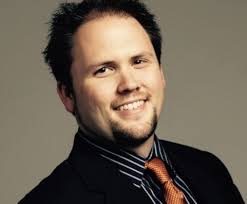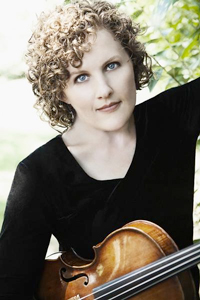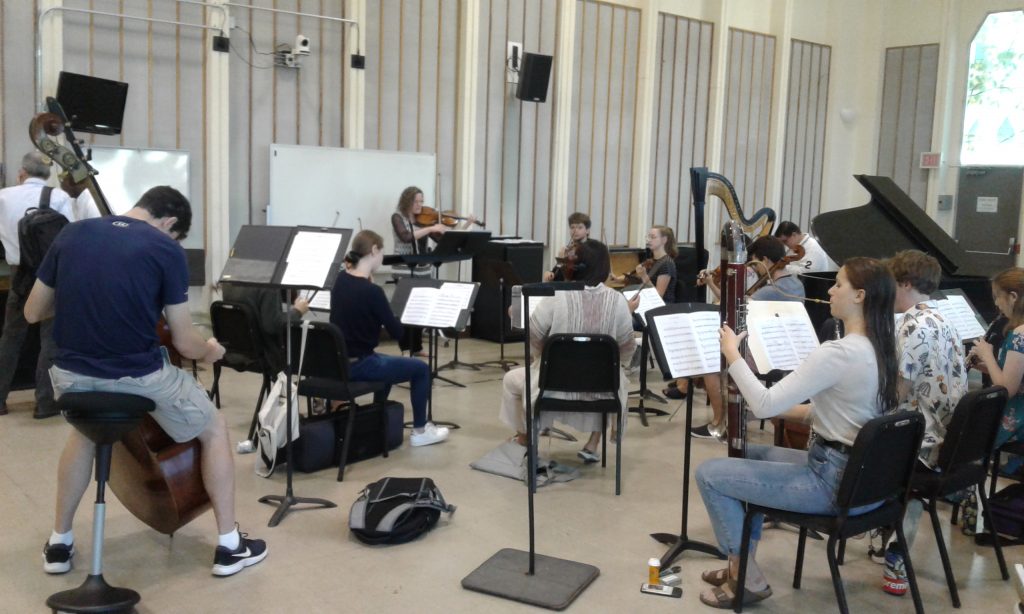by Mike Telin

In the other life, he is a mandolinist/composer who has appeared on A Prairie Home Companion and performed at the Oregon Bach Festival, Wintergrass, and the Sister’s Folk Festival, and toured with the genre-bending ensemble String Helix. In March of this year, he and his duo partner, bassist Craig Butterfield, released their third album, Eclipse, on Summit Records.
In spite of his success in both lives, Jones has always been reluctant to combine the two. That changed when he was presented with the opportunity to write a new viola concerto.
On Friday, September 27 at 7:30 pm in Warner Concert Hall, Oberlin viola professor Kirsten Docter will premiere Jesse Jones’ Viola Concerto with the Oberlin Contemporary Music Ensemble. The program, conducted by Timothy Weiss, also includes Charles Ives’ The Unanswered Question, Aurie Hsu’s Mosaic, Pauline Oliveros’ Horse Sings from Cloud, and the premiere of Kari Watson’s Sunburnt Monoliths. The concert is free and you can also catch it on a webcast.
Following a rehearsal, I sat down with Jones and Docter in her studio and asked the composer what led him to his decision to incorporate his folk music into one of his classical pieces. “I’m a mandolin player, and I’ve been writing tunes in my living room for two decades,” he said. “But it’s only been in the last five years that I’ve started to play them with my musical partner Craig Butterfield — we’re both Edgar Meyer and Chris Thile fans. And since a lot of modern composition doesn’t use themes anymore, I thought, I have all these tunes that I think are catchy, so I’m going to use them in this concerto. Because, why not?”
Each of the Concerto’s four movements is based on one of Jones’ original tunes. “Moderato – movendo” draws on A-25, “Scherzoso – funky” on Jangled, “Larghissimo – molto Lirico” on Lulu’s Theme, and “Andantino – Jig – Finale” on Narny. (Click on the links to hear performances by Jones and Butterfield.)
Was a concerto full of bluegrass tunes what Docter expected to receive? “No, it wasn’t,” she said, “but if you’ve heard any of Jesse’s music, you know that it’s stylistically diverse. I think the folk music makes this concerto very friendly — it’s rhythmic, and the slow movement has a beautiful, long melodic line.”
Pointing to a score of Bartók’s Viola Concerto, Jones said that he was trying to think like that composer when writing his own. “I didn’t listen to it anew before I wrote this piece, but I was thinking about his technique of transcribing Hungarian folk songs and incorporating them in ways that were accepting of chromatic treatment. I tried to do the same thing with my tunes. I’ve found this all to be quite refreshing.”
Docter said that because Jones is incredibly thorough in his writing, getting her viola to sound like a fiddle has not been too difficult. “Jesse is great at notation, and transferring the mandolin chords to the viola worked really well. We didn’t have to rewrite anything.”
Still, the violist was happy to have had most of the summer to learn the 35-minute piece. “I did have to think differently,” she said. “Listening to the clips of Jesse’s tunes helped a lot with understanding the style. I played for him a few times and got some feedback.”
The Concerto is scored for single winds and brass, piano, harp, percussion, and strings. Jones noted that he needed to be sure he created enough space for the viola to be heard. “There’s a lot of ensemble writing, but then it shuts up so the soloist can play.”
He also chose to notate the rhythmic style of the tunes. He said that is safer than writing straight eighth notes for a group of string players and telling them to swing. “I’ve seen that backfire on composers, so I tried my best to mimic the stylistic tropes of swing, and notate it as such. At the same time, I didn’t want to be too overt with that because it could seem cloying. I wanted to make a piece of modern music that played off all of that by using weird orchestration, some funky notes, and a bit of modernism here and there, like multiphonics in the clarinet.”

Both composer and soloist had high praise for Timothy Weiss and the members of CME. They’re also relishing being able to create a new work in an educational setting. “Often with a concerto, the orchestra rehearses and does their thing, the soloist comes in the day before the concert, and you put it together,” Docter said. “But with this, anytime they’re rehearsing I’m there. It’s a great thing.”
Jones said that it is a luxury to have the time to work out so many details. “I’ve had premieres with only an hour’s rehearsal, and they are disastrous. This process is so much more rewarding because everybody cares.”
Is this concerto the start of something new for Jones? “I have dozens of these tunes and I’m thinking that I’ll start incorporating them in my work more often. I’ve done a lot of what I might call acid harmony — it’s astringent, very chromatic, and dissonant. What I’m more and more interested in is something that is very melodic but still retains a level of sophistication.”
Published on ClevelandClassical.com September 24, 2019.
Click here for a printable copy of this article




